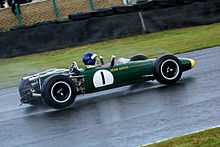The Lotus 43 was a Formula One racing car designed by Colin Chapman for the 1966 season. Hampered by its heavy and unreliable BRM engine, it won only one race, the 1966 United States Grand Prix.
Concept

Lotus 43 at the BTCC Knockhill 2014

Lotus 43 being demonstrated in 2014
The Lotus 43 was partially based on the Lotus 38 Indycar, due to Chapman's experience at Indy with larger engine capacity and tyre/suspension setup. The car was designed in this way in response to new regulations which came into force in 1966, which increased the engine capacity to 3 litres. Along with newer, wider tyres better able to handle the power of the larger engines, the need for a more robust design was obvious.
Chapman and Lotus made a deal for use of BRM's new P75 H16 engine as well as using the new tyres. The engine on paper was technically advanced and powerful, and Chapman had hopes that it would power his cars to another successful season.
The car was supposed to debut driven by Peter Arundell at the 1966 Monaco Grand Prix, but it was unavailable. Its first outing at the following Belgian Grand Prix ended during practice, when the engine gave out.[3]
The first sign of trouble was when the new engine arrived and it required four men to lift it from the truck. The engine proved to be overweight, unreliable and was unable to produce the promised power. Jim Clark didn't score any points until mid season. Clark was able to turn his fortunes around and won the 1966 United States Grand Prix at Watkins Glen at the end of the season, the only race win for the P75 engine. In 1967 the 43 made its final start in the South African Grand Prix at the Kyalami circuit, where Clark again retired the car.
The 43 chassis was an excellent design let down by a poor powerplant, and design elements of it were used in the design of its 1967 successor, the far more successful Lotus 49, including the use of the engine as a stressed structural member which bore weight and to which the rear suspension was attached.
Complete results
Formula One World Championship results
(key) (results in bold indicate pole position; results in italics indicate fastest lap)
- 1 Total points scored by all Lotus-BRM cars, including 4 points scored by drivers of Lotus 33 variants.
- 2 Total points scored by all Lotus-BRM cars, including 6 points scored by drivers of Lotus 33 variants.
Non Championship results
PC simulation
A driveable, detailed reconstruction of the Lotus 43 (with matching car physics) appeared in 2007 in the freely-available '66 Mod' for the PC-based racing simulation Grand Prix Legends.
References


